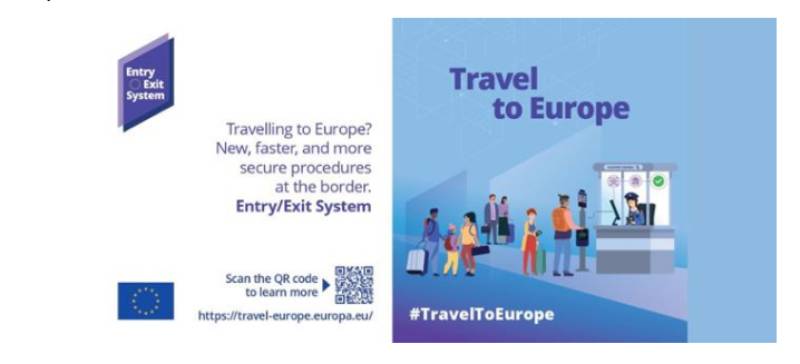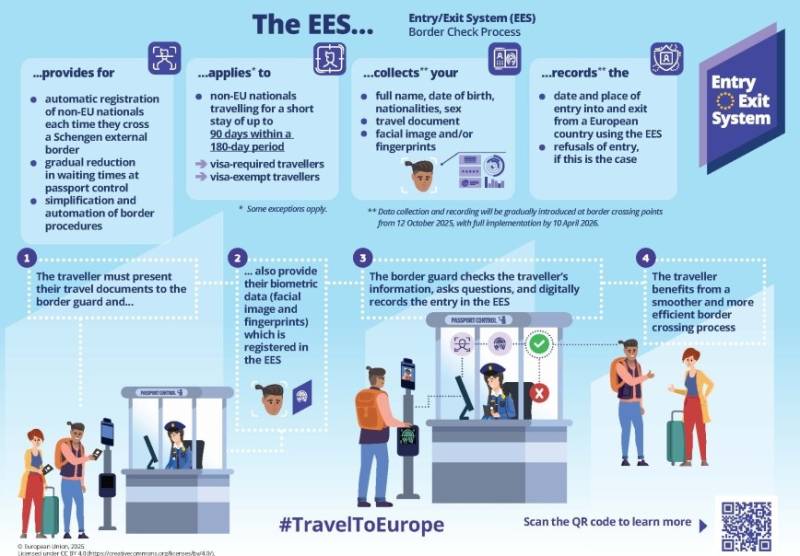Date Published: 08/10/2025
New EU border controls: What British travellers to Spain need to know before October 12
ARCHIVED ARTICLE -
Everything you need to know about Europe’s Entry/Exit System (EES) as millions of British tourists prepare for new registration requirements
If you're planning a trip to
Spain or anywhere else in Europe in the coming months, there's an important change to border procedures you need to be aware of. From Sunday October 12, which also happens to be
a national holiday in Spain for ‘Spain Day’, a new digital system will transform how non-EU citizens enter and exit participating countries.
Understanding the Entry/Exit System (EES)
The Entry/Exit System, known as EES, represents a fundamental shift away from the traditional passport stamp. Instead of manual stamps, travellers will have their details recorded digitally using biometric technology.
This new approach applies to anyone visiting from outside the EU, including the British, for short stays of up to 90 days within any 180-day period, covering everything from beach holidays to quick business trips.
The system has been designed with two main goals in mind: making it easier to enforce the 90-day limit and helping to tackle cross-border crime.
Rather than launching everywhere at once, the EES will be introduced gradually between October 12, 2025 and April 9, 2026, giving countries time to get their systems up and running smoothly.
It is worth pointing out that the EES checks need not apply to any non-EU citizens who hold residency of an EU country, such as British, US and Australian citizens who are empadronado in Spain.
What happens at the border?
When you arrive at passport control, expect to have your fingerprints scanned and your photograph taken. Some locations may offer self-service kiosks or even mobile applications where you can register your information, although availability will vary depending on where you're travelling.
For families with young children, the process is slightly different. Anyone under the age of 12 will only need to have their photograph taken, without the fingerprint requirement.
The good news is that this registration is only necessary on your first trip under the new system. Once your details are stored, subsequent border crossings should actually become quicker. Your information will be kept on file for three years after each journey, meaning passport control on future visits will simply involve verifying what's already recorded.
Travellers with e-passports, which can be identified by a small golden camera symbol on the cover, will be able to use automated gates for an even faster experience.
Allow extra time initially
While the system is designed to speed things up in the long run, it's sensible to expect some delays during the roll-out period. Queues at border control may be longer than usual as travellers go through the registration process for the first time, particularly during busy travel periods.
Most countries will keep the existing passport stamp system running alongside the EES during the transition, but a handful of nations, including Estonia, Luxembourg and the Czech Republic, are expected to be ready to switch to the new system straight away from next week.
Which countries are involved?
The EES will be implemented across 30 European countries. This includes popular destinations like Spain, France, Italy, Greece and Portugal, as well as Austria, Belgium, Bulgaria, Croatia, the Czech Republic, Denmark, Estonia, Finland, Germany, Hungary, Iceland, Latvia, Liechtenstein, Lithuania, Luxembourg, Malta, the Netherlands, Norway, Poland, Romania, Slovakia, Slovenia, Sweden and Switzerland.
How to prepare for your trip
The straightforward answer is that there's nothing you need to do in advance. You can’t pre-register or complete any paperwork ahead of time. The entire process happens when you arrive at your point of entry, whether that's an airport, seaport or land border.
Simply make sure you arrive at the airport or port with plenty of time to spare, especially if you're travelling during peak season or through one of the major hubs that serve Spain.
More changes in 2026
Under ETIAS, British travellers will need to apply for authorisation online before their trip. The application will cost £17.30 (€20) and will remain valid for three years or until your passport expires, whichever comes first.
Make sure you apply for your ETIAS before you travel and double-check that it's linked to the passport you'll actually be using for the trip.
Advice for British travellers
With these significant changes taking effect, here are the key points to remember:
- Build extra time into your journey, particularly over the next few months while everyone adjusts to the new system. The initial registration process may take longer than you're used to and queues could build up during busy periods.
- Keep an eye out for self-service options when you arrive at border control. Where available, kiosks and mobile apps may help you complete the process more quickly once everything is fully operational.
- Remember that ETIAS is coming next year. Don't leave it until the last minute to apply for your travel authorisation and always check it's valid and connected to the correct passport before you set off.
- Stay informed by checking official guidance before each trip. With millions of British travellers expected to be affected by both the EES and ETIAS changes over the coming year, being prepared will help ensure your journey goes as smoothly as possible.
Images: Gov.pl/eu-Lisa
article_detail

|















